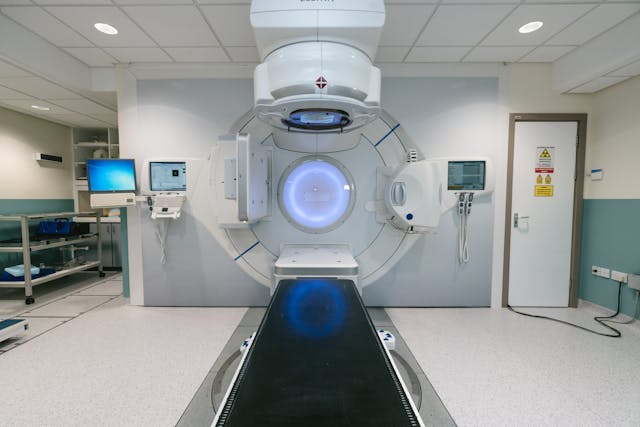28 October 2024
Introduction
This case study examines the use of a technique used when treating patients with radiotherapy that requires the patient to understand verbal instructions through a speaker. Its use led to unequal access to care among non-English speaking patients.
Background
Radiotherapy is a common treatment for breast cancer. Radiation destroys cancer cells in the treated area but also affects normal cells. This can cause side effects in the treatment area.
Patients having treatment to the left breast or internal mammary chain (IMC) can benefit from holding their breath during radiotherapy. When you hold your breath after inhaling, your lungs fill with air and your heart moves further away from your breast tissue. This means it is easier to avoid hitting the heart with radiation because there is more space between the healthy tissue of the heart and the treatment area of the breast. Reducing the radiation dose to the heart protects it from long-term radiotherapy dose induced side effects.
Radiotherapy takes a couple of minutes to deliver in total and most people cannot hold their breath for this long. The clinical team therefore ask patients to hold their breath for multiple stretches of up to 20 seconds. The radiographer treating the patient talks over a speaker into the room and coaches the patient how and when to hold their breath whilst turning the radiation beam on and off in time with the patient’s movements. This technique is called deep inspiration breath hold (DIBH). Not everyone is able to do DIBH because it requires the ability to hold your breath for up to 20 seconds.
Description of the Bias or Harm
Due to the need to understand verbal instructions, patients who do not speak English were not referred for DIBH. This means non-English speaking patients having left sided breast and/or IMC radiotherapy were missing out on one of the techniques used to reduce radiotherapy dose to their heart.
Analysis and Contributing Factors
Telephone or face-to-face interpreters are regularly used for communicating with non-English speakers during radiotherapy consultations. However, the use of interpreters in radiotherapy clinical areas is problematic due to issues with accessibility, patient dignity, safety and cost.
Mitigation and Recommendations
Radiographers recognised that not offering certain treatment techniques based on a patient’s ability to understand English was not in keeping with the Trust’s commitment to Equality, Diversity and Inclusion. They undertook a project to review the use of live translations via a translator app. The translator app was successfully adopted to translate DIBH instructions for non-English speaking breast patients, enabling access and availability to this technique with minimal additional staff input and cost. This is an excellent example highlighting on-going issues with accessibility for all non-English speakers. It is also a strong example of how a team can drive meaningful change from the inside out.

Photo by Photo By: Kaboompics.com
Glossary of Terms
Radiotherapy
A treatment for cancer using radiation to treat cancer.
DIBH
Deep Inspiration Breath Hold, a radiotherapy technique to reduce dose to the heart during left-sided breast radiotherapy.
Exclusion criterion for referrals
Factors which disqualify individuals from being referred to a particular program, service or study.
References
Jo Strickland, Cornelia Iosub, Wendy Goldshaker, Marina Khan, Deirdre Dobson. “Delivering deep inspiration breath hold (DIBH) breast radiotherapy to non-English speaking patients”. Poster presented at UKIO 2024, Liverpool, UK.




